Image Guided Interventions
we offer Image Guided Interventions—advanced procedures that use real-time imaging techniques to diagnose, guide, and treat a wide range of medical conditions with accuracy and minimal invasiveness. These interventions help improve patient outcomes by reducing recovery time, lowering complication risks, and improving the precision of treatments.

Types of Image Guided Interventions
Angiography and Angioplasty (using fluoroscopy to assess and treat blood vessel blockages)
Biopsies (taking tissue samples from organs or tumors using CT, ultrasound, or MRI guidance)
Drainage Procedures (abscess or fluid drainage guided by ultrasound or CT)
Embolization (blocking abnormal blood flow, such as in tumors or aneurysms)
Vertebroplasty/Kyphoplasty (injecting cement into fractured spine bones)
Radiofrequency or Microwave Ablation (destroying tumors with heat using imaging guidance)
Nerve Blocks and Pain Management Injections (guided by ultrasound or fluoroscopy)
What are Some Common Uses of the Procedure?
Treating blocked or narrowed blood vessels
Guiding cancer treatments or biopsies
Relieving pain from nerve or joint conditions
Draining infected or excess fluid collections
Treating aneurysms, varicoceles, or uterine fibroids
Managing spinal fractures or tumors
How Do I Prepare for My Image Guided Intervention?
Preparation depends on the type of procedure. General guidelines include:
Follow fasting instructions if required (usually no food 4–6 hours before the procedure)
Inform your doctor about all medications, allergies, and medical conditions
Arrange for someone to drive you home if sedation is used
Wear comfortable clothing and remove any jewelry or metal objects
Your healthcare team will give you detailed instructions specific to your procedure.
What Will Happen During My Image Guided Intervention?
You’ll be positioned on a procedure table in an imaging suite
The area of treatment will be cleaned and numbed with local anesthesia; sedation may be given if needed
Using imaging guidance (ultrasound, CT, MRI, or fluoroscopy), the doctor will precisely navigate small instruments (like catheters, needles, or guidewires) to the target area
The procedure is typically painless, though you may feel some pressure or mild discomfort
After completion, you’ll be monitored for a short period before discharge
What Are the Reasons for an Image Guided Intervention?
Doctors recommend Image Guided Interventions for:
Diagnosing diseases or infections when non-invasive tests are inconclusive
Minimally invasive treatment when surgery is too risky or unnecessary
Delivering targeted therapies directly to tumors or problem areas
Reducing symptoms such as pain, swelling, or restricted blood flow
Why is Angiography Used?
Angiography is an imaging test that uses X-rays and contrast dye to visualize blood vessels throughout the body. It helps:
Diagnose blockages or narrowing in arteries or veins
Identify aneurysms or malformations
Guide treatment during procedures like angioplasty or stenting
Evaluate blood flow before or after surgery
By providing a detailed roadmap of the vascular system, angiography plays a critical role in planning and performing life-saving interventions.
